Lexicon of the Hamas Organization
The ISIS Flag
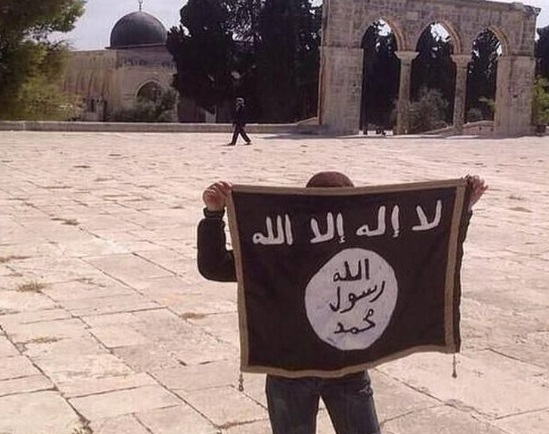
A youngster waiting Isis flag in Jerusalem. Credit: ‘Stand With Israel’ FB page.
The flag of ISIS (Islamic State of Iraq and Syria) has become a globally recognized symbol associated with jihadist movements and fundamentalist ideologies. Its presence in the Middle Eastern conflict, particularly in relation to Hamas, has raised significant concerns, especially highlighted during the events of the October 7th massacre in Israel.
Historical Background of ISIS
ISIS emerged as a significant force in the early 2000s, initially as part of Al-Qaeda in Iraq, before evolving into an independent entity. The group gained international notoriety for its brutal tactics and attempts to establish a caliphate in Iraq and Syria. Its flag, a black standard bearing the Shahada in white calligraphy, became emblematic of its cause.
The Meaning of the ISIS Flag
The jihadist flag, commonly used by various Islamist and fundamentalist movements, typically features the Black Standard with the Shahada, the Islamic declaration of faith. The variant used by ISIS includes a depiction of the seal of Muhammad, believed to be historical, emphasizing their claim to religious and political legitimacy.
Ties Between ISIS and Hamas
Isis Flag found in Kibbutz Sufa, Israel. Credit: Yoseph Haddad’s FB page.
The relationship between ISIS and Hamas has been a subject of significant scrutiny. Both groups share a fundamentalist Islamist ideology, but their objectives and methods have often differed. However, recent events have indicated a more direct connection.
During the October 7th, 2023 massacre, orchestrated by thousands of armed Hamas terrorists, the use of ISIS flags by Hamas operatives was reported. This event saw the destruction of large parts of the Gaza security fence and a brutal invasion into southern Israel by Hamas terrorists, who committed atrocities against civilians. Reports noted that Hamas terrorists hung an ISIS flag while attacking a kibbutz in Israel, further indicating the ties between these groups in their shared hostility towards Israel.
The October 7th Massacre and the ISIS Flag
The October 7th massacre marked a chilling convergence of Hamas’s violence with ISIS symbolism. The use of the ISIS flag by Hamas terrorists during this attack not only highlights the shared extremist ideologies but also raises questions about the broader implications of their cooperation. This event, characterized by extreme brutality, marked a significant moment in the Hamas-Israel conflict, with the ISIS flag symbolizing a unified front against Israel under the banner of extremist Islamist ideology.
Conclusion
The ISIS flag, with its distinct design and historical roots, has become more than just a symbol of a single extremist group; it has evolved into a broader emblem of jihadist intent and fundamentalist ideology. The association of this flag with Hamas during the October 7th massacre in Israel serves as a stark reminder of the complex and often intertwined nature of militant Islamist movements in the Middle East. Understanding these connections is crucial for anyone seeking to comprehend the multifaceted dynamics of the region’s ongoing conflicts.
Lexicon of the Hamas Organization
Qasem Soleimani

Qasem Soleimani. Credit: Bloomberg FB page.
Qasem Soleimani, born on March 11, 1957, in Qanat-e Malek, Kerman Province, Iran, was a prominent figure in the Middle Eastern geopolitical landscape, particularly in the context of the Israel-Iran conflict. His career in the Islamic Revolutionary Guard Corps (IRGC) and his leadership of the Quds Force marked him as a key player in shaping Iran’s foreign military and political strategies.
Early Life
Soleimani’s early life was marked by hardship. He left school at 13 to work on construction sites, helping to repay his father’s debts. Influenced by the sermons of Hojjat Kamyab, a protégé of Ali Khamenei, he began engaging in revolutionary activities.
Military Career
Joining the IRGC in 1979 following the Iranian Revolution, Soleimani quickly advanced, playing a significant role in suppressing a Kurdish uprising and serving in the Iran-Iraq War (1980-1988). His strategic and brave actions during the war earned him rapid promotions.
Command of Quds Force
Soleimani assumed command of the IRGC’s Quds Force between 1997 and 1998. Under his leadership, the Quds Force evolved into an elite unit for covert and expeditionary warfare, extending Iran’s geopolitical influence across the Middle East.
Role in the Israel-Iran Conflict
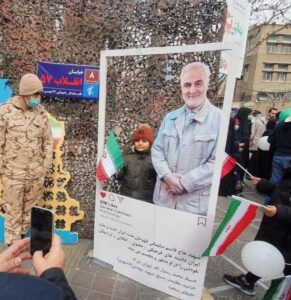
An Iranian child next to Sulimani’s cut out. Credit: Israel Defence forces FB page.
Soleimani’s strategic military interventions were pivotal in shaping the Israel-Iran conflict. He was instrumental in the creation and maintenance of Hamas’ tunnel warfare network in the Gaza Strip. This strategy effectively brought Iran’s influence to Israel’s borders, altering regional dynamics.
Arming and Training Iran’s Proxies
Under Soleimani’s command, the Quds Force played a crucial role in supporting and arming Iran’s proxies, like Hezbollah in Lebanon and Hamas and the Palestinian Islamic Jihad in Gaza. These groups received substantial funding, training, and weapons from Iran, enabling them to conduct operations against Israel. In Syria, instead of using a terrorist proxy, Iran directly entrenched itself, influencing the political and military actions of the Assad regime. This involvement allowed Iran, alongside Hezbollah, to establish military bases near Israel’s northern border.
Assassination

Anniversary of Sulimany’s assassination. Credit: Anadolu Agency FB page.
Soleimani was assassinated on January 3, 2020, by a U.S. drone strike near Baghdad International Airport. This act escalated tensions between the U.S. and Iran, sparking debate over its legality and repercussions. Iran termed the attack as state terrorism, leading to heightened hostilities, including Iran’s missile attacks on U.S. forces in Iraq.
In conclusion, Qasem Soleimani’s life and career were deeply intertwined with the military and political developments in the Middle East. His actions and strategies significantly influenced Iran’s foreign policy and its conflict with Israel. His assassination marked a pivotal moment in ongoing tensions between Iran and the United States, with far-reaching implications for regional stability and the Israel-Iran conflict dynamics.
Legacy on the Arab Israeli Conflict
Qasem Soleimani’s legacy in the Arab Israeli conflict is marked by his strategic and tactical contributions to Iran’s proxy groups in the region. His efforts in arming, training, and guiding organizations like Hezbollah, Hamas, and Palestinian Islamic Jihad significantly intensified the conflict’s dynamics. By empowering these groups, Soleimani helped solidify Iran’s role as a key player in the conflict, projecting its influence directly to Israel’s borders. His actions fostered an environment of heightened tension and frequent confrontations, leaving a lasting impact on the security and political landscape of the Middle East. His death, while altering the immediate strategic calculations, has not diminished the long-standing influence of the strategies he implemented in the region.
Lexicon of the Hamas Organization
Al Shifa Hospital
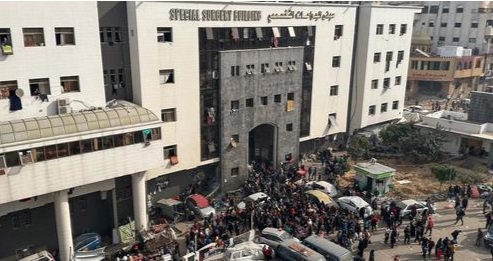
Shifa Hospital. Credit: ‘Washington Post’ FB page.
Al-Shifa Hospital, the largest medical facility in Gaza, has played a significant role in the region’s history, particularly during various conflicts involving Israel and Palestinian factions. This article provides an overview of the hospital’s background, its role in conflicts and the controversies surrounding it.
Background and History
Al-Shifa Hospital, originally a British Army barracks, was transformed into a hospital in 1946. During the 1948 Arab Israeli War, it became one of Gaza’s primary medical facilities. Following the war, the Egyptian administration expanded the hospital, adding various departments. Post the 1967 Six-Day War, when Israel occupied Gaza, the entire Egyptian hospital staff was taken prisoner, and subsequently, the hospital underwent significant renovations and expansions under Israeli administration. This included the addition of a large basement in the 1990s, which later became a point of controversy regarding its use.
Use During the 2007 Fatah-Hamas Conflict
During the Fatah-Hamas conflict in June 2007, Al-Shifa Hospital became a site of violence between the two factions. The conflict led to the deaths of members of both groups within the hospital premises. Hamas also reportedly dismissed hundreds of Fatah-affiliated medical staff and used the hospital as a strategic location. This period was marked by fear and violence within the hospital, severely affecting its operation and medical staff.
Role in the Wars with Israel
Al-Shifa Hospital has been central during various wars between Israel and Gaza. For instance, during the 2008-2009 Gaza War, the hospital was overwhelmed with casualties due to Israeli airstrikes. Allegations surfaced that Hamas used the hospital as a military base, a claim that was difficult to verify due to restricted access to Gaza by journalists. These allegations have been a recurrent theme in subsequent conflicts, contributing to the complexity surrounding the hospital’s role in the region.
Al-Shifa Hospital in the 2023 Israel-Hamas War

Hamas Tunnels under Al-Shifa Hospital. Credit: Ohad Hemo’s FB page.
The 2023 Israel-Hamas war brought Al-Shifa Hospital back into the spotlight. Israel and the U.S. accused Hamas of using the hospital as a command center, for storing weapons, and holding Israeli hostages.
Legal and Ethical Implications
The use of Al-Shifa Hospital in armed conflict raises significant legal and ethical questions. Under international law, hospitals enjoy protected status, which is jeopardized if the facility is used for military purposes. The allegations and counter-allegations regarding the hospital’s use in the 2023 conflict illustrate the challenges in maintaining this protected status in a war zone. The international community’s response and the calls for investigation highlight the complexities of warfare in densely populated urban areas like Gaza.
Conclusion
Al-Shifa Hospital’s history is deeply intertwined with the broader geopolitical and humanitarian issues in the Gaza Strip. Its role in various conflicts, especially the recent 2023 Israel-Hamas war, underscores the challenges of operating a major medical facility in a conflict zone. The hospital not only provides essential medical services to the population of Gaza but also represents the difficulties faced in preserving humanitarian spaces in times of war.
Lexicon of the Hamas Organization
Saleh al-Arouri
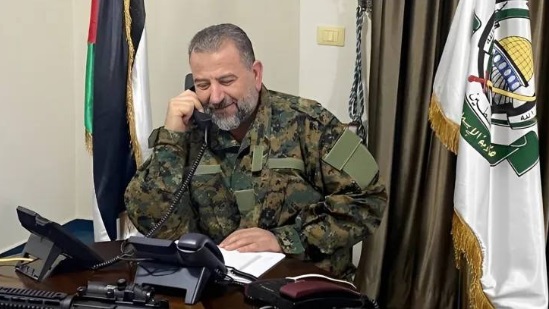
Saleh al-Arouri. Credit: ‘Eadio 786’ FB page
Saleh al-Arouri is a prominent Palestinian figure known for his deep involvement with Hamas. His association with Hamas has placed Saleh al-Arouri in the spotlight of the Israeli-Palestinian conflict.
Early Life and Involvement with Hamas
The early life of Saleh al-Arouri is marked by his gradual involvement with Hamas. This organization, known for its political and militant activities against the State of Israel, became a platform for Saleh al-Arouri to rise as a significant leader. His roles within the group have been diverse, encompassing both political strategy and militant operations.
Leadership and Strategy

Saleh al-Arouri and Ayatollah Khamenei - Iran’s former leader. Credit: Hillel Fuld’s FB page.
As a leader in Hamas, Saleh al-Arouri has been involved in planning and directing various activities in the West Bank. His leadership style and strategic decisions have significantly influenced the group’s operations in this region. Saleh al-Arouri’s approach often mirrored the overarching goals and tactics of Hamas, particularly in relation to the Israeli-Palestinian conflict.
Assassination of Saleh al-Arouri
Saleh al-Arouri, was assassinated on January 2, 2024, in a strike on an office in the Dahieh neighborhood of Beirut, Lebanon. This strike, widely believed to be carried out by Israel, also resulted in the deaths of six other individuals, including high-ranking Hamas militants. His assassination occurred just a day before the fourth anniversary of the assassination of senior Iranian military commander Qassem Soleimani.
-
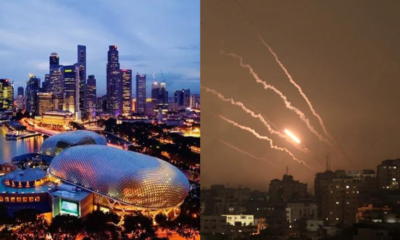
 News4 months ago
News4 months agoGaza could Have Been Singapore. Hamas Turned It Into a living nightmare
-

 News4 months ago
News4 months agoRape, slaughter, and atrocities—see the real face of Hamas
-

 News4 months ago
News4 months agoShe died while saving lives.
-

 News4 months ago
News4 months agoTrigger warning: This is the atrocity that’s happening in Israel right now
-
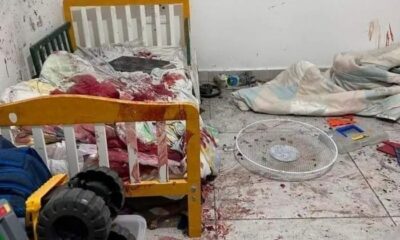
 News4 months ago
News4 months agoMonsters: Yahya Sinwar and Hamas kidnapped 150+ children and women.
-

 News4 months ago
News4 months agoKidnapping elderly and children: Hamas are no heroes
-

 Hamas War Strategy, Tactics, and PR4 months ago
Hamas War Strategy, Tactics, and PR4 months agoThe War Crimes of Hamas and ISIS in Exploiting Civilians
-

 News4 months ago
News4 months agoHamas turns a music festival into a massacre






